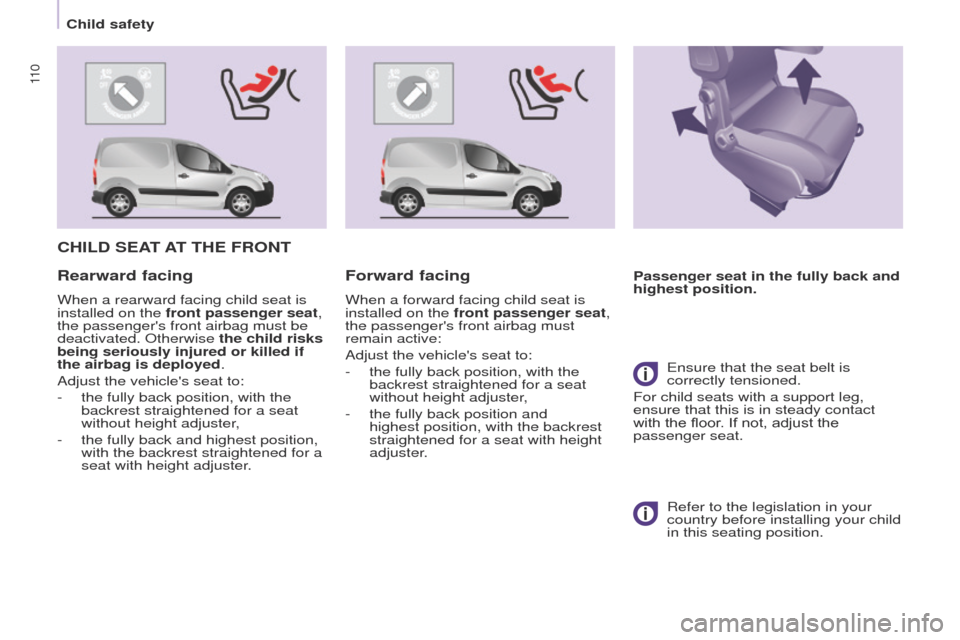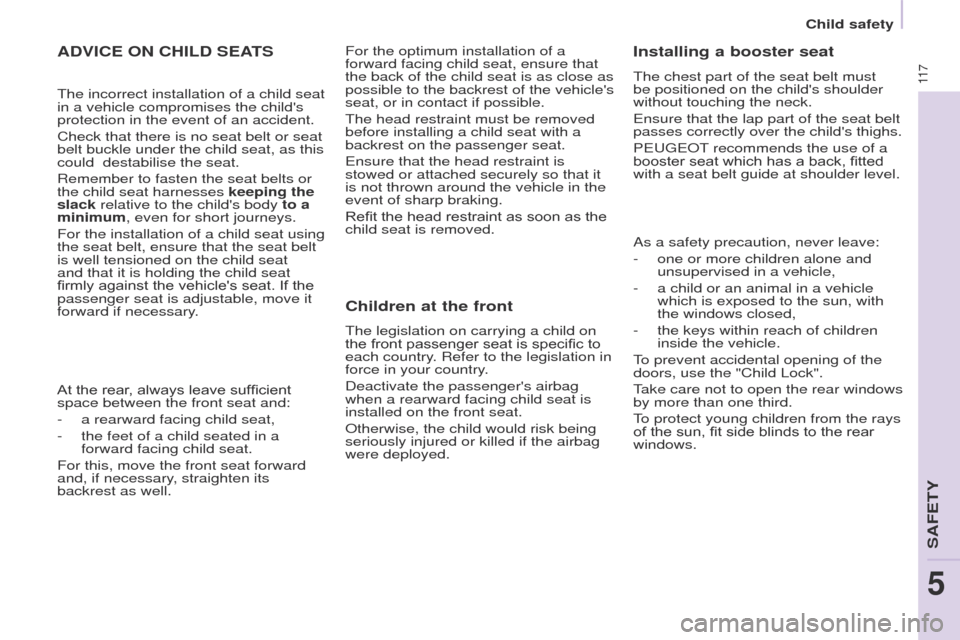Page 111 of 260
109
Partner-2-VU_en_Chap05_Securite_ed02-2016
CARRYING CHILDREN
General points
Although one of PEUGEOT's main
criteria when designing your vehicle,
the safety of your children also
depends on you.
*
The regulations on carrying children
are specific to each country
. Refer
to
the legislation in force in your
country.
For maximum safety, please observe
the following recommendations:
-
in accordance with European
regulations,
all children under the
age of 12 or less than one and
a half metres tall must travel in
approved child seats suited to
their weight, on seats fitted with a
seat belt or ISOFIX mountings*,
-
statistically
, the safest seats in
your vehicle for carrying children
are the rear seats,
-
a child weighing less than 9
kg
must travel in the rearward
facing position both in the front
and in the rear.
SAFETY
5
Child safety
Page 112 of 260

11 0
Partner-2-VU_en_Chap05_Securite_ed02-2016
CHILD SEAT AT THE FRONT
Passenger seat in the fully back and
highest position.Rearward facing
When a rearward facing child seat is
installed on the front passenger seat,
the passenger's front airbag must be
deactivated. Otherwise the child risks
being seriously injured or killed if
the airbag is deployed.
Adjust the vehicle's seat to:
-
the fully back position, with the
backrest straightened for a seat
without height adjuster
,
-
the fully back and highest position,
with the backrest straightened for a
seat with height adjuster
.
Forward facing
When a forward facing child seat is
installed on the front passenger seat,
the passenger's front airbag must
remain active:
Adjust the vehicle's seat to:
-
the fully back position, with the
backrest straightened for a seat
without height adjuster
,
-
the fully back position and
highest position, with the backrest
straightened for a seat with height
adjuster
. Ensure that the seat belt is
correctly tensioned.
For child seats with a support leg,
ensure that this is in steady contact
with the floor. If not, adjust the
passenger seat.
Refer to the legislation in your
country before installing your child
in this seating position.
Child safety
Page 116 of 260
11 4
Partner-2-VU_en_Chap05_Securite_ed02-2016
RECOMMENDED SEATS
Group 0+: from birth to 13 kgL1
"ROMER Baby-Safe Plus"
Installed in the rearward facing position
Groups 2 and 3: from 15 to 36 kg L4
"KLIPPAN Optima"
From 22 kg (about 6 years), the booster is used on its own.
L5
"RÖMER KIDFIX"
Can be fixed on the vehicle's ISOFIX mountings. The child is restrained by the seat belt.
PEUGEOT offers a range of recommended child seats which are secured using a three point seat belt.
Child safety
Page 117 of 260
11 5
Partner-2-VU_en_Chap05_Securite_ed02-2016
LOCATIONS FOR CHILD SEATS SECURED WITH THE SEAT BELT
U: seat suitable for the installation of a child seat secured using the sea\
t belt and universally approved, rearward facing
and/or forward facing.Seat
W eight of the child and indicative age
Under 13 kg
(groups 0 (b) and 0+)
Up to approx 1 year From 9 to 18 kg
(group 1)
1 to 3 years approx
From 15 to 25 kg
(group 2)
3 to 6 years approx
From 22 to 36 kg
(group 3)
6 to 10 years approx
Row 1 (c) (d)Individual
seat
U
UUU
Bench,
outer seat U
UUU
Bench,
centre
seat (e) U
UUU
In accordance with European regulations, this table indicates the option\
s for installing child seats secured using a seat belt
and universally approved (a) according to the weight of the child and \
the seating position in the vehicle.
SAFETY
5
Child safety
Page 119 of 260

11 7
Partner-2-VU_en_Chap05_Securite_ed02-2016
ADVICE ON CHILD SEATS
The incorrect installation of a child seat
in a vehicle compromises the child's
protection in the event of an accident.
Check that there is no seat belt or seat
belt buckle under the child seat, as this
could destabilise the seat.
Remember to fasten the seat belts or
the child seat harnesses keeping the
slack relative to the child's body to a
minimum, even for short journeys.
For the installation of a child seat using
the seat belt, ensure that the seat belt
is well tensioned on the child seat
and that it is holding the child seat
firmly against the vehicle's seat. If the
passenger seat is adjustable, move it
forward if necessary.
At the rear, always leave sufficient
space between the front seat and:
-
a rearward facing child seat,
-
the feet of a child seated in a
forward facing child seat.
For this, move the front seat forward
and, if necessary
, straighten its
backrest as well. For the optimum installation of a
forward facing child seat, ensure that
the back of the child seat is as close as
possible to the backrest of the vehicle's
seat, or in contact if possible.
The head restraint must be removed
before installing a child seat with a
backrest on the passenger seat.
Ensure that the head restraint is
stowed or attached securely so that it
is not thrown around the vehicle in the
event of sharp braking.
Refit the head restraint as soon as the
child seat is removed.
Children at the front
The legislation on carrying a child on
the front passenger seat is specific to
each country. Refer to the legislation in
force in your country.
Deactivate the passenger's airbag
when a rearward facing child seat is
installed on the front seat.
Otherwise, the child would risk being
seriously injured or killed if the airbag
were deployed.
Installing a booster seat
The chest part of the seat belt must
be positioned on the child's shoulder
without touching the neck.
Ensure that the lap part of the seat belt
passes correctly over the child's thighs.
PEUGEOT recommends the use of a
booster seat which has a back, fitted
with a seat belt guide at shoulder level.
As a safety precaution, never leave:
-
one or more children alone and
unsupervised in a vehicle,
-
a child or an animal in a vehicle
which is exposed to the sun, with
the windows closed,
-
the keys within reach of children
inside the vehicle.
T
o prevent accidental opening of the
doors, use the "Child Lock".
Take care not to open the rear windows
by more than one third.
To protect young children from the rays
of the sun, fit side blinds to the rear
windows.
SAFETY
5
Child safety
Page 145 of 260

143
Partner-2-VU_en_Chap08_Aide-rapide_ed02-2016
ECONOMY MODE
After the engine has stopped, with
the key in the ignition position, certain
functions (windscreen wiper, electric
windows, courtesy lamps, audio
equipment, etc.) can only be used for a
cumulative duration of thirty minutes, to
prevent discharging of the battery.
Once the thirty minutes have elapsed,
the active functions are put on standby
and the battery warning lamp flashes
accompanied by a message in the
screen.
To resume the use of these functions
immediately, start the engine and let it
run for a few minutes.
The time available will then be double
the time for which the engine was left
running. However, this time will always
be between five and thirty minutes.
A flat battery will prevent the
engine from starting.
TEMPORARY PUNCTURE RE -
P
AIR KIT
The kit is located in one of the two
storage compartments located under
the front seats.
Vehicles supplied with a temporary
puncture repair kit do not have a spare
wheel or tooling (jack, wheelbrace, ...).
The temporary tyre repair kit consists
of a compressor and a bottle
(containing a sealant).
Using the kit
- Tick the deflated wheel on the speed limitation sticker then affix
the sticker to the vehicle's steering
wheel to remind you that a wheel is
in temporary use.
-
Clip the bottle
1 on the
compressor
2.
-
Connect the bottle
1 to the valve of
the tyre to be repaired.
-
T
ake care to unwind the
compressor pipe before connecting
it to the bottle.
-
Connect the power lead to one of
the vehicle's 12V sockets.
-
Switch on the compressor by
pressing button
A until the tyre
pressure reaches 2.0 bars. If this
pressure cannot be reached, the
tyre cannot be repaired.
-
Remove and store the compressor
.
-
Drive immediately
, for a few miles
(kilometres), at reduced speed, to
fill the puncture.
-
Adjust the pressure using the
compressor in accordance with the
recommendation for the vehicle and
check that the leak is filled correctly
(no further loss of pressure).
-
Drive at reduced speed (50
mph
[80 km/h]). The tyre must be
examined and repaired by a
specialist as soon as possible.
QUICK HELP
8
Changing a wheel
Page 160 of 260
158
Partner-2-VU_en_Chap08_Aide-rapide_ed02-2016
Passenger compartment fuses
Fuses F Amperes
A Allocation
1 - Not used
2 20 Heated seats
3 - Not used
4 15Folding mirrors relay
5 15 Refrigeration equipment socket relay
Towing / towbar /
coachbiuilders
/ floor cab fuses
The designations communicated are
an indication only as this additional
box relates to other information which
depends on the converter-coachbuilder
for which the handbook cannot be
used as a technical support.
Fuses F Amperes
A Allocation
1 15Not used
2 15Ignition, generator operating relay
3 15Trailer 12V supply
4 15 Permanent supply for the modifiers
5 40 Hazard warning lamps
Changing a fuse
Page:
< prev 1-8 9-16 17-24